Rules of bicycle polo for 5 players in France |
Bicycle polo is a team game that consists of hitting a ball in the other team's goal according to the following rules (governed by the French Federation of Cycling - F.F.C.):
The French Cycling Federation (F.F.C.) governs the demonstrations of bicycle polo which takes place outdoors or covered areas on approved grounds.
Organizers, officials and competitors must conform to the General Rules of the F.F.C. and, in all circumstances, depend on the application of the aforesaid rules.
The players of each team, including the substitutes, must be provided with a license for the current year. This license must be issued by the F.F.C. or another federation affiliated to the U.C.I.. Players must adopt the uniforms of racing cyclists (shirts with the colors of their club) and are provided with bicycles not comprising any dangerous accessory for other players or themselves.
Females with a license can take part.
The playing fields must be approved by the Regional Commission for matches on a regional level or by the National Commission for meets on a national or inter-regional level.
3.1. National Commission: receives delegation of the Federal Management Committee to deal with all the problems regarding bicycle polo on a national level, in particular the organization of the national meets (championships, cups), the appointment of the FFC referees and the distribution of the decisions of the Federal Management committee.
3.2. Regional Commission: receives delegation of the Regional Management Committee to deal with any problems regarding bicycle polo, particularly the organization of regional meets (championships, cups), appointment of regional referees; it submits proposals and distributes the decisions submitted by the National Commission.
3.3. Private organizations or clubs: any organizer of a meeting of bicycle polo must conform to the General Rules of the F.F.C.
Clubs must be affiliated and in conformity with the F.F.C. and their Regional Committee.
3.4. The receiving club or the organizer must ensure the safety of players and managers of the visiting team.
The meets announced as national, as well as regional and national championships, are only open to the players who hold a license issued by the F.F.C.
5.1. Conforming to articles 332 to 378 of the General Rules of the F.F.C., the penalties cover, according to the gravity of the fault made, the following situations: temporary or final expulsion, warnings, blame, fines, temporary suspension or probation.
5.2. These penalties are decided, according to the case, by the referee, the Regional Committee, the National Sports Commission or the Federal Management Committee.
5.3. The referee can declare the temporary or final expulsion of a player in fault. He can declare a sanction by a simple mention on the match sheet.
5.4. In view of the report by the referee, the Regional Committee (or Regional Commission, if it has received delegation) can declare a temporary suspension going up to four consecutive matches, with or without a fine, the amount of which is limited (article 336 of the General Payments of the F.F.C.). All requests for an increase in sanction must be made at the National Sports Commission or at the Federal Management Committee (articles 337 and 338 of the General Payments of the F.F.C.).
5.5. The sanctioned player can make an appeal under the conditions of articles 356 and 362 of the General Payments of the F.F.C. A request for an appeal can only be made in the case of a suspension higher than four consecutive matches.
Pursuant to the General Payments of the F.F.C., a referee, obligatorily a member of the F.F.C., is appointed in bicycle polo meets. He is assisted by two goal judges and two linesmen, jointly appointed in agreement with the captains of the involved teams.
The referee can take the responsibility of playing the match in the event of dissension or the absence of his assessors.
In all cases, the referee must have a license delivered by the F.F.C. for the current year. He must be of legal age. He referees on foot.
7.1. Functions: The referee has the absolute direction of the play, he is the only person qualified to make a decision. In the event of dispute, he can ask the opinion of the linemen and the goal judges. He establishes the match sheet before the meet in the presence of the two captains who give the players’ licenses to the referee. He signs the match sheet with both captains at the end of the play.
7.2. Uniform: The referee must have an appropriate uniform, distinguished by its color from that of the players of the two teams (black is recommended).
7.3. Designation: The referee is designated beforehand by the National or Regional Commission for the official meets or by the organizers for the other meets.
7.4. Absence: In the event of absence, a referee can be designated by common agreement between the two captains. If not, the match is postponed.
7.5. Injuries: In the event of an injury of the referee during the course of a meet, he can indicate his replacement with or without the captains’ assent.
7.6. Appointments: The federal referees are appointed by the National Commission. The regional and departmental referees are named by the Regional Commission. A federation card can be delivered to the referees.
The appointment is valid for one year and renewable. Requests for appointments are sent to the President of the concerned Commission.
An official report of the meet is established on plain paper or a form specifically printed for this purpose and provided by the organizer. This official report must mention, among other things:
The referee can also summarize any incidents that occurred during the meet and the behavior of the players and coaches.
The maximum number of players written on the match sheet is ten. Only these players are allowed to play.
The match sheet, duly filled out and signed, is sent by the referee to the organizer of the meet.
Chapter 9 - Modification of the payment
Any modification of the payment must be the object of deliberation by the National Commission of Bicycle Polo. Any modification of the rules of the game must, furthermore, to be the subject of a one year preliminary provisional application.
Bike polo is a game of team which has as target to enter a ball in the goal of the opponent team according to the following rules:
Article 1 - Dimensions of the field
1.1. The field is rectangular. It measures 100 metres (109.36 yd) in length by 60 metres (65.616 yd) in width. Nevertheless, these dimensions can vary between 80 and 110 metres in length (87.488 yd to 120.296 yd) on 40 to 70 metres in width (43.744 yd to 76.552 yd).
1.2. This field is divided in two equal parts by a median line parallel to the end lines, passing through the center of a circle with a radius of 10 metres (10.936 yd).
1.3. The penalty zone (or surface) has for dimensions: 5 metres (5.468 yd) to left of the goal, 5 metres of goal width and 5 metres to straight of goal, i.e. a width of 15 metres (16.404 yd) and a depth of 7 metres of large (7.6552 yd) from the end line.
1.4. The point of penalty is situated 10 metres (10.936 yd) from the end line in the axis of the goal.
1.5. All lines delimiting the field (the penalty zone, the median line and the center circle) must be indicated with chalk or paint. In no case are they to be indicated by a ditch or a stop.
1.6. No enclosure or obstacle (slope, tree, etc.) may be found less 2 metres (2.19 yd) from the sidelines or less than 5 metres (5.468 yd) from the end line.

2.1. The goal posts shall be 5 metres apart (inside measure) and the crossbar shall be 2,75 metres above the ground.
2.2. The supports for the crossbar may not be more than 10 centimetres (3,937 in.) in diameter. The crossbar and the goal posts must be rounded.
2.3. To the extent of the possible, nets are to be put in place to stop the ball when it goes in the goal. To avoid all argument, they have to prevent the passage of the ball. This is why they have to be anchored to the field and made of a material strong enough to retain the ball.
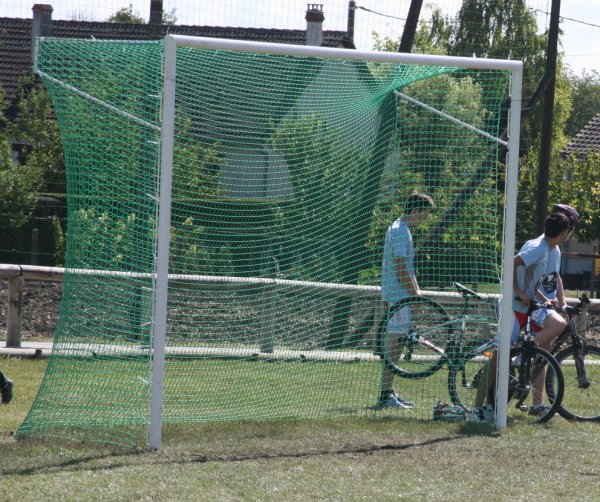
3.1. The ball has a maximum diameter of 15 centimetres (5,9055 in.) and minimum of 12 (4,7244 in.). It has to be sufficiently inflated.
3.2. Each team has to bring a ball in good condition. Before the game, there shall be a coin flip, and the team losing the coin flip shall supply the ball for the first half of the game, while the team winning the coin flip shall supply the ball for the second half.
3.3. During play, if the ball is burst or unplayable, the referee shall stop the game. With a new ball, he resumes play with a face-off (see article 22.4.) at the point where the game was stopped. If play is stopped in the penalty zone, the face-off is played according to article 24.6.
3.4. If the ball is burst on a throw-in, it will be played again with a new ball.

4.1. The head shall have the following maximum dimensions:
4.2. The cane or shaft may be rigid or flexible to the taste of the player. The total length (including the head) does not have to exceed one meter (40 in.).
4.3. The use of iron (o any other kind of iron) is forbiden, except for linking the head to the cane, as far as it does not represent a danger for the players.

The bicycle is composed of a frame, two wheels, a handlebar, a saddle, a one-speed gear, a chain, a chain-wheel, two pedal-cranks and two pedals. Moutain bikes are authorised as far as they obbey to the following rules:
5.1. The development may not be greater than 3.50 metres (3.8276 yd.).
5.2. The handlebar has to be heavily padded. All secondary harmful guesswork is forbidden (bottle carier, kickstand, toe clips, metallic pedals, brake levers).
5.3. The total length of the bicycle may not exceed 1.80 metres (1.96848 yd.).
5.4. Any object intended to prevent the ball from passing through or under the frame is forbidden.

Article 6 - Appearance of players - Helmet
6.1. All players on a team have to wear the same uniform, with the exception of the goal-keeper.
6.2. The goal-keeper shall wear a uniform that, by its color, distinguishes it clearly all the other players (member of a same team and adversaries).
6.3. In the case where players of the two teams have uniforms of similar colors likely to be confused, players of the visiting team have to change to different uniforms. If the encounter takes place on a neutral field, the team required to change uniforms will be decided by lot.
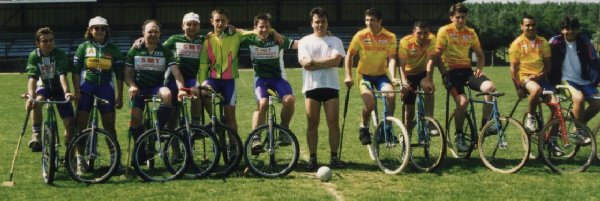
6.4. Each player shall wear a helmet for cycling.
Article 7 - Composition of the team
A team is composed 10 players, with no more than five to be on the field at one time. One of the players on the field is designated as goal-keeper, others being called field players. The five players remaining are called substitutes.
8.1. On each team, one of 10 players is designated as captain. He alone has the right to speak to the referee, to make complaints or to ask for explanations.
8.2. If the captain leaves the field due to injury or expulsion, he or she shall designate a new captain and inform the referee of the change.
Three of five substitutes may enter the game under the following conditions:
9.1. Upon request of the captain to the referee and after the agreement of the referee, a player leaves the field by crossing the nearest boundary line before his substitute enters the game near the median line.
9.2. The substitute comes on the field immediately after the exit of the player replaced. At no time a team has to have more than 5 players on the field.
9.3. The replaced player becomes a substitute and can re-enter the game by following the process in section 9.1., above.
9.4. Changes of players are not limited in number and can take place at any given time, including during overtime and penalties periods.
9.5. The time elapsed during these changes is recorded by the referee and added to the regular time in the same manner as time elapsed during other stoppages of play.
Article 10 - Duration of the match
The game has an effective duration of 60 minutes, separated in 2 periods of 30 minutes each by a half-time of 5 to 10 minutes in duration.
11.1. The choice of is to be determined by coin flip by the referee in the presence of the two captains.
11.2. The winner of the coin flip shall choose which end his team shall defend in the first half, and the loser shall have the benefit of the kick-off.
11.3. In second half, the winner of the coin flip benefits from the kick-off after having changed of ends.
12.1. To be authorized to touch the ball or to attack an adversary, the player has to hold his mallet in the right hand and his handlebar in the left hand, and may not be touching the ground.
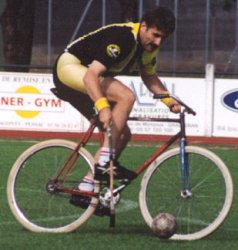
12.2. The goalkeeper benefits from specific authorizations mentioned in article 19.
Article 13 - Start of the game - Kick-off
13.1. To begin the match or after a scored goal, the ball is placed at the center of the field to be kicked off in direction of the opposing team's goal.
13.2. All players have to be in their respective half of the field. Only players of the team taking the kick-off are allowed in the center circle. Opposing players can enter the circle as soon as the ball has been hit or hit at.
13.3. The player taking the kick-off can cross the median line to hit the ball.
13.4. In addition to the 3 paragraphs above, players are bound by the rules in paragraphs 3, 4 and 5 of article 24.
13.5. The kick-off after a marked goal is made by the team that allowed the goal.
13.6. A goal made directly from a kick-off shall be counted.

Article 14 - Ball out of bounds
14.1. When the ball goes across the sideline, the opponents of the last player to touch the ball shall be awarded a kick-off from the point where the ball crossed the line.
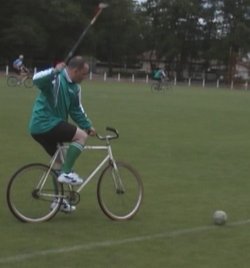
14.2. When the ball goes across the end line, and was last touched by the attacking team, the defending team shall be awarded a kick-off as outlined in article 14.3, below. If the ball was last touched by a member of the defending team, the attacking team shall be awarded a corner, as outlined in article 14.4, below.
14.3. For a kick-off after the attacking team hits the ball over the end line, the ball is placed at the intersection of the end line and the lateral limit of the penalty zone, on the side of the goal where the ball crossed the end line.
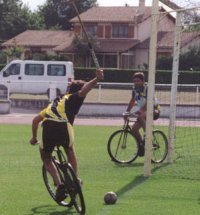
14.4. For a corner hit, the ball is placred at the intersection of the end line and the side line, on the side of the goal where the ball crossed the end line.
14.5. If the ball leaves the field by passing above the goal, the kick-off shall be made on the same side of the axis of the goal as the ball crossed the end line.
14.6. Goals scored directly from kick-offs or corner hits shall be counted.
14.7. A ball must be completely outside and clear of the line to be out of bounds.
14.8. All the players but the one who will hit the ball, shall be more than 10 metres (10.936 yd) from the ball, except the goal keeper who, in a kick-off after the attacking team has hit the ball over the end line, can be on the goal line between the goal posts. The goal keeper (or the player at his place) shall not hit the ball if the ball is less than 10 metres (10.936 yd) from his initial position.
Article 15 - How the game is stopped
15.1. Play is stopped only when the referee blows the whistle.
15.2. Time elapsed while play is stopped shall be added by the referee to the regular time of the period during which the stoppage occurs (regulation or overtime).
15.3. If play is stopped and cannot be started again in a maximum period of 30 minutes (due to injury to the referee or unplayable field, for example) , the referee shall stop the game and address a report to the organizer of the event for further action.
15.4. The time elapsed between goals and subsequent kick-off or when the ball is out of play is not added to the end of the period by the referee.
16.1. A goal counts as one point.
16.2. A goal is marked when the ball passes between 2 goalposts and below the crossbar.
16.3. A goal is valid only if the whole ball has crossed the goal line.
16.4. If a player diverts or sends the ball into his own goal, the point is granted to the opposing team.
16.5. The team with the greater number of points at the final whistle shall be declared the winner.
17.1. In case of a tie score at the end of the regular time, in a game in which a winner must be determined (e.g. a playoff game or an elimination tournament), the teams shall play 2 overtime periods of 10 minutes each. There is no rest between these 2 periods, but only a change of ends. The choice of ends to begin the first period is determined by the procedure in article 11.
17.2. In case of a tie at the
end of the two overtime periods, a series of penalties shall be
taken by 4 players from each team. These players and the goal
keeper shall be designated to the referee by the captain from
among the 10 players of his team.
Series of penalties will unfold as follows:
1) Only one goal, chosen by the referee, is used.
2) A coin flip shall be done by the referee in the presence of
the 2 captains. The winner of the coin flip has the choice to go
first or second in the series of penalty shots.
3) Each team's goalkeeper shall play alternately against a player
of the opposing team. The shooting team's goal keeper shall stand
behind the end line and beyond the limit of the penalty area (5
metres - i.e. 5.468 yd - beyond the goalposts).
4) The order in which the 4 players undertake their shots is
indicated to the referee by each captain before the first shot is
taken.
5) Players of each team wait their turn to shoot a minimum
distance of 10 metres (i.e. 10.936 yd) behind the point of
penalty. After having taken his shot, each player returns to his
place behind those who have not yet taken their shots.
6) At the end of the series, the team having obtained the largest
number of points is declared the winner.
7) In case of a tie after the series of four shots for each team,
another series of shots shall be played by the same players and
in the same order (see § 4) until a winner is determined.
8) To count as a goal, the ball has to enter the goal directly or
off a deflection by the goal keeper and/or the goalposts and/or
the crossbar. The shooter may not touch the ball a second time
under any circumstances.
9) The shooter and the goal keeper are both bound by the
procedures outlined in article 25 (Penalty).
Subject to article 12, a player may:
18.1. Prevent an opponent from hitting the ball by putting his mallet across the path of the opponent's. A player may not, however, lift an opponent's mallet and must withdraw his mallet immediately after blocking an opponent's shot.
18.2. Take a full swing if no opponent is nearby.
18.3. Juggle the ball by bouncing it on the mallet.
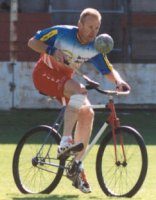
18.4. Play the ball or to score a goal with the wheels of the bicycle.
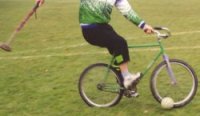
18.5. Play the ball on his left when he is not covered on his right by an opponent.
18.6. Ride outside the side or endlines to make a play.
18.7. Hit the ball with the head or any part of the body (except as stated in article 22.2.13).
18.8. Do anything else not forbidden by these rules.
Inside the penalty area, the goalkeeper may:
19.1. Place himself and his bicycle in the path of an adversary. The goalkeeper has the right of way as defined in the article 20. All opponents have to yield to him.
19.2. Repel or deflect the ball with his left hand after taking it off the handlebar.
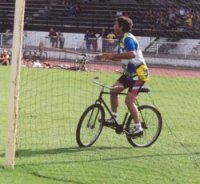
19.3. Jump from his bicycle to repel or deflect the ball before touching the field. In this action, if the ball is deflected or stopped by the bicycle, there is penalty if the player is no longer in contact with its bike.
19.4. Stop or release an aerial ball with his feet.
The right of way is given to the player who follows or possesses the ball. In the penalty area, he loses his right of way in favor of the goalkeeper.
When 2 players go face to face to the ball, each of them shall keep it on his right (mallet) side. When two players of the same team advance abreast, the ball between them, the player who has the ball on his left has to give way if an opponent rides to meet the ball.
22.1. Any violation of the present game rules may be declared a foul and sanctioned by a free shot at the place where it happened. A foul committed by a player in his team's penalty area is sanctioned by a penalty shot. If the referee believes a foul is not detrimental to the team fouled, he may let the play continue (for example, if the team fouled maintains control of the play). The referee can count a goal scored after a foul by the defending team. This provision shall be known as the "rule of the advantage". The referee may cancel his decision of leting the play continue if the rule of the advantage does not give an advantage to the team fouled.
22.2. A player may not:
1) Jostle or shoulder an opponent.
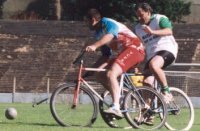
2) Block or impede a player who
does not have the ball.
3) Play or touch the ball with a foot on the ground.

4) Play or touch the ball without
holding his handlebar with his left hand.
5) Carry the ball with his body, mallet, or bicycle.
6) Put his mallet in the wheel or across the bicycle of an
opponent.
7) Attack an opponent who has the ball from the opponent's left
side.
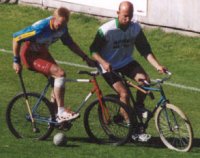
8) Block the path or to zigzag ahead a player having the right of way.
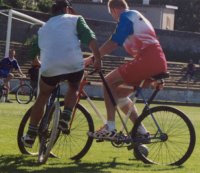
9) Stop ahead of the player in
possession of the ball.
10) Throw or drop his bicycle or mallet to stop the ball or to
impede an opponent.
11) Place his
wheel between the bicycle of an opponent and the ball.
12) Throw his bike or his mallet in from of an opponent.
13) Intentionally play the ball with his foot.
14) Ride his bicycle in a dangerous manner or while the bicycle
is in a dangerous condition (for example, inverted handlebar,
broken pedal, jumped chain, broken saddle, etc.).
15) Hit or hold an opponent's mallet.
16) Play the ball on his left if he is being covered by an
opponent on his right.
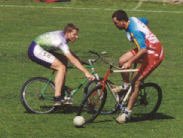
17) Block or deflect the ball with
his left hand after taking it off the handlebar.
18) Insult or threaten anyone, or contest decisions of the
referee.
22.3. Article 19 (goalkeeper) takes precedence over the preceding section (22.2.) in case of contradiction.
22.4. If the referee calls simultaneous fouls on both teams, he shall have a face-off like this: 2 players, one from each team, start face to face, each facing his opponent's goal. The referee shall drop the ball halfway between the two players. The ball can be touched only after it bounces. If the fouls are called in the penalty area, the face-off is played following the procedure of the article 24.6. All the other players have to be at least 10 metres (10.94 yd) away when the ball is dropped.
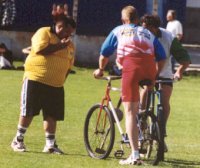
If a violation occurs in the penalty area, the referee can order a kick-off by a player of the defending team at the point the violation occurred, but not if a foul was committed by a member of the defending team.
Article 24 - Resumption of play
24.1. After a stoppage of play, the referee shall blow the whistle to resume play.
24.2. All players, but the one who is taking the kick-off, have to remain 10 metres (10.94 yd) from the ball until it is hit or hit at, except the goal keeper (or the player who is at his place) if the ball is less than 10 metres (10.94 yd) from his goal mouth. In that cas, the goal keeper (of the player who is at his place) may be on the goal line between the goal posts. The other players can enter this 10-metre area as soon as tha ball has been hit or hit at. The referee shall watch to make sure the opponents are clear of the 10-metre area before blowing the whistle.
24.3. The player taking the kick-off may hit the ball only once, and may not hit it again until it has either covered a distance of 10 metres (10.94 yd) or been hit or hit at by an other player.
24.4. The ball is considered kicked off when it has covered an equal distance to its circumference (approximately 50 centimetres). If the hitter fails to hit the ball at least this distance, the referee shall blow the whistle and order a new kick-off.
24.5. If the player muffs the kick-off by sending the ball against his wheel or his bicycle, the referee shall let play contine, unless the shot goes directly in goal, in which case the referee shall blow the whistle and order a new kick-off.
24.6. If a foul is committed outside the penalty area, but less than 10 metres (10.94 yd) from the goal, the referee shall place the ball at least 10 metres (10.94 yd) from the goal in order to allow defending players to place themselves on the field but at least 10 metres (10.94 yd) from the ball. The referee shall place the ball on the line from the center of the goal through the point of the foul, keeping the angle to the center of the goal constant.
25.1. When there is penalty,
the referee has to ensure that the players are positioned as
follows:
1) The goal keeper must be on the end line between the goalposts
and at least 10 metres from the ball.
2) The players of the fouling team must be behind the end line
and beyond the lateral limits of the penalty area with two
players on each side of the goal.
3) The hitter is near the ball.
4) The players of the team fouled must be at least 10 metres from
the fouling team's end line.
25.2. Before blowing the whistle to resume play, the referee has to insure that the goal keeper and the hitter are immobile and ready for play, and that the other players are properly positioned.
25.3. After the referee blows
the whistle:
1) The hitter may hit the ball, either stationary or while moving.
2) The goal keeper may move along the goal line or in toward the
ball, but he may approach within maximum one meter of the ball.
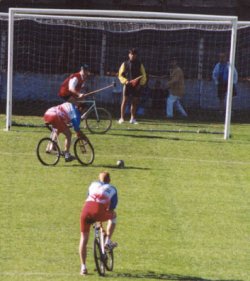
25.4. If the ball is deflected by the goalkeeper, the crossbar, or a goalpost, the ball is again in play. All players, including the hitter, may then play it.
25.5. If the ball stops before reaching the end line, only the goalkeeper is authorized to touch it. In the meantime, the other players must remain in their respective places (see article 25.1.).
Article 26 - Players out of the game
If a player persists in committing intentional
fouls for the purpose of preventing an opponent's play, or
commits dangerous fouls, the referee may exclude him from all or
part of the remainder of the game.
The succesive steps concerning the use
of the yellow and red cards are following:
-
1: oral warning;
- 2: yellow card with or
without expulsion
of 2 minutes
- 3: red card with definitive
expulsion of the fouling player and replacement of him after 5 minutes.
According
to the seriousness of the foul, the referee may use directly the step 2 or 3.
The yellow and red cards given in a match shall be written on the match sheet.
Furthermore, the fouling player may incur sanctions in accordance to general regulations of the French Cycling Federation.
The referee alone may judge the appropriateness of fouls and may not be contested by anyone during the match. He shall be considered "part of the field". If the ball is deflected off the referee, it is still in play, and a goal scored on a such a deflection may be counted.
The end of a half is generally whistled by the referee to the either after a kick-off or when the ball is in the middle of the field. The referee shall allow sufficient time for a penalty, a corner or a free kick to be converted.
Article 29 - Forfeit - Incomplete team
29.1. A team shall forfeit the game if, a quarter of an hour after the scheduled time for the kick-off, it cannot present at least 4 players on the field.
29.2. Only the organizer who hosts the game has the power to ratify the forfeit.
29.3. A team may be admitted to play if it is composed of a minimum of 4 players. If several members of the same team are rendered unavailable by injury or expulsion, and if the team is no longer able to present the minimum 4 players on the field, the referee shall stop the game and inform the organizer.
Article 30 - Accidents - Change of equipment
30.1. No repair of equipment may be made on the field. A player must leave the field to replace or repair his equipment.
30.2. The referee may require a player to change equipment if he considers the equipment dangerous (broken mallet, broken pedal or jumped chain, for example).
30.3. In case of injury, a player must leave the field to obtain medical care. Each injuried player with bleeding shall receive first aid out of the field.
Article 31 - Substitutions during play
31.1. After an injury or a change of equipment, any player coming in during the play must cross the side line within 10 metres of the midfield line.
31.2. The goalkeeper is authorized to enter play by crossing the end line.
31.3. The player must ask and receive permission from the referee before entering the game.
31.4. Any player registered on the team's lineup roster may be admitted to play, even if he is not present at the beginning or during the game.
Article 32 - Condition of the field
If the field is rendered unplayable before or during the game, the referee has the sole authority to suspend and/or resume play. He may ask the advice of the 2 captains.
home - history - links - material - medias - news - rules - schedules - teams